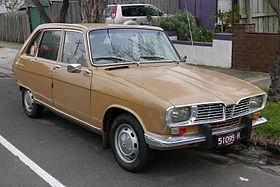Renault 16
| Renault 16 | |
|---|---|

Renault 16 TL
|
|
| Overview | |
| Manufacturer | Renault |
| Also called | Renault R16 |
| Production | 1965–1980 |
| Assembly |
Sandouville, France Flins, France West Heidelberg, Australia |
| Designer | Gaston Juchet |
| Body and chassis | |
| Class | Large family car (D) |
| Body style | 5-door hatchback |
| Layout | MF layout |
| Powertrain | |
| Engine |
A-Type 1.4 L I4 A-Type 1.5 L I4 A-Type 1.6 L I4 |
| Transmission | 4-speed manual 5-speed manual 3-speed automatic |
| Dimensions | |
| Wheelbase | Left: 2,720 mm (107.1 in) Right: 2,650 mm (104.3 in) |
| Length | 4,240 mm (166.9 in) |
| Width | 1,628 mm (64.1 in) |
| Height | 1,450 mm (57.1 in) |
| Curb weight | 980 kg (2,160 lb)-1,060 kg (2,340 lb) |
| Chronology | |
| Predecessor | Renault Frégate |
| Successor | Renault 20/30 |
The Renault 16 (R16) is a large family hatchback produced by French automaker Renault between 1965 and 1980 in Le Havre, France.
In the early 1960s Renault was building a series of small cars, like the hatchback Renault 4 and rear engine Renault Dauphine and aimed to replace its larger family car, the Renault Frégate model (1951–1960) which had managed a modest production total of 163,383 units.
The R16 was a great success, with 1,845,959 R16s produced during a production run of 15 years. The car sold well in most of Europe, winning praise for its spacious and comfortable interior. It was marketed in the United States, but was not successful and only a few were sold.
Interestingly, Citroën was designing an extremely similar car in the early 1960s (Projet F), to bridge their own enormous market gap between the tiny 2CV and luxury DS models. When Citroën realized that Renault was introducing the R16, they took the unusual step of canceling Projet F. Due to the similarity of construction, rumours of Renault conducting industrial espionage abounded, but were never proven.
Under the skin, the layout of the R16 is similar to the Citroën Traction Avant – front-wheel drive, engine mounted inline behind the transmission. torsion bar suspension, and column mounted shift. In addition the car had an aluminum engine and an electric cooling fan, both technical innovations.
The big innovation was the modern, practical body style – introducing the hatchback to the mid-size family segment. This allowed the interior to be immensely flexible, and could be configured in seven different ways. This body style is halfway between a saloon and an estate, and, before the term hatchback was coined, journalists struggled to describe it. A review in the English Motoring Illustrated in May 1965 stated: "The Renault Sixteen can thus be described as a large family car but one that is neither a four door saloon and nor is it quite an estate. But, importantly, it is a little different."
...
Wikipedia
